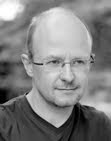Positives
 Today I got the B&W chromes back from Photostudio 13 in Stuttgart. I took the Contax Aria and two lenses - the 45/2.8 pancake (Adlerauge) and the 135/2.8 - with me on the trek through the Karakoram, loaded with Maco/Rollei IR film. Exposed at 100 asa and after Scala-development it results in beautiful B&W slides. I must say they offer me more satisfaction than the batch of 6x9 negatives I brought back. There is something wrong with these negatives. I have been scanning a bunch and I don't like what I'm seeing. The texture, tone scale and sharpness of these images is seriously off kilter. It just doesn't look like a medium format negative (compared to a 4x5" it is simply horrible). Zooming in shows serious grain and very coarse textures, sometimes akin to crayon smudges. I took the negatives to Johan Doumont who has a better scanner than I have. But also the Nikon LS9000 doesn't work wonders with these negs. A raw scan results in a marginally better image. After sharpening up with a dedicated plug-in, there is a noticeable difference. It really is better. But not up to the point that one could say that it is real MF quality.
Today I got the B&W chromes back from Photostudio 13 in Stuttgart. I took the Contax Aria and two lenses - the 45/2.8 pancake (Adlerauge) and the 135/2.8 - with me on the trek through the Karakoram, loaded with Maco/Rollei IR film. Exposed at 100 asa and after Scala-development it results in beautiful B&W slides. I must say they offer me more satisfaction than the batch of 6x9 negatives I brought back. There is something wrong with these negatives. I have been scanning a bunch and I don't like what I'm seeing. The texture, tone scale and sharpness of these images is seriously off kilter. It just doesn't look like a medium format negative (compared to a 4x5" it is simply horrible). Zooming in shows serious grain and very coarse textures, sometimes akin to crayon smudges. I took the negatives to Johan Doumont who has a better scanner than I have. But also the Nikon LS9000 doesn't work wonders with these negs. A raw scan results in a marginally better image. After sharpening up with a dedicated plug-in, there is a noticeable difference. It really is better. But not up to the point that one could say that it is real MF quality. Johan hypothesised that the emulsion has suffered from reticulation due to high temperature differences during development. This leads to cracks in the gelatine layer and clustering of grains. I don't know. As far as I am aware, the negs were developed and fixed at 24°C. You'd need seriously colder rinsing water to get reticulation. According to Guy Meurs, my supplier of all things film, reticulation does happen but you really need to torture the film and it is very difficult to replicate. He thinks Tri-X can suffer quite a bit of beating without getting into trouble. I have sent a scan to Guy who will show it to the Kodak people. Maybe we'll hear more about it. Net result is that I will need to restrict print sizes to very modest dimensions.
The chromes are much better, luckily. There's quite a few good images. I'm glad I took the Contax after all. Picture above was taken on the Lupke La pass, at around 5600m. Pierre Neyret, our guide, makes a late afternoon stroll with the looming mass of Baintha Brakk, 7200m, in the background.


0 Comments:
Post a Comment
<< Home